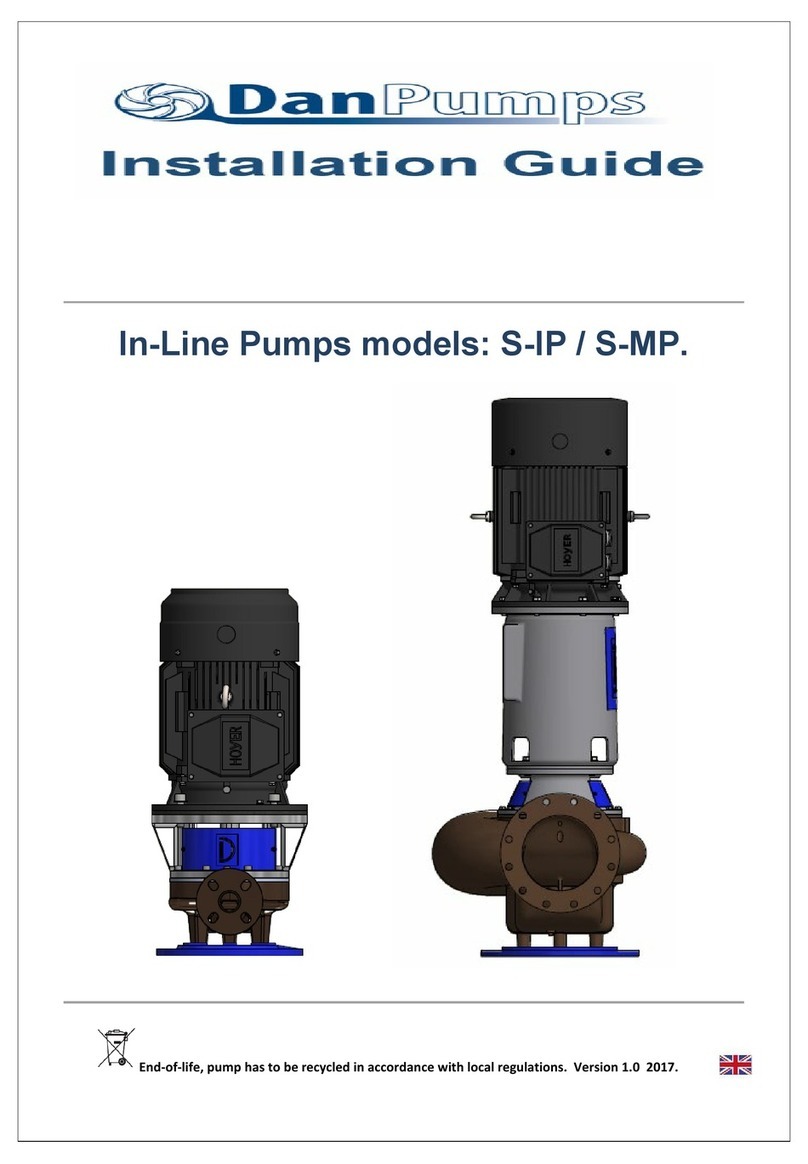
Check the stator unit.
If the motor protection trips repeatedly, the stator must be inspected. Open the terminal housing cover.
Disconnect the stator wires (spring terminals). Check the insulation resistance with min. 500V insulation
tester. Test between U1, V1 and W1 and to GND.
Test between U1, V1 and W1. The insulation resistance must exceed 1 mega ohm. If the insulation
resistance is below 1 mega ohm, clean the stator and dry it in an oven for 2-3 hours at 100°C.
Check the circuit of the three built-in thermal overload switches using a buzzer or other measuring device.
Before reconnecting:
Check that the motor cable has no broken wires. Check the motor cable insulation with a 500V insulation
tester, between the wires.
Removal of the stator housing.
Mark the stator housing position on the bearing house to be able to reinstall correctly. Remove the six
screws fixing the stator casing. Lift the stator casing approx. 5 cm from the shaft and rotor - use a hoist.
Disconnect the wire from the moisture sensor. Continue lifting off the stator housing.
Disassembling the rotor and bearings.
When the stator housing has been removed, the shaft with rotor and bearing has to be lifted out. (Lower
bearing will stay in the lower bearing house).
Do not reuse worn bearings or bearings which have been in contact with water.
Assembling.
Clean all O-ring grooves and all other contact surfaces carefully. Use a wire brush when necessary. Change
all O-rings. Lubricate all O-rings with oil or grease to prevent the O-rings from getting stuck or damaged
when remounted. Also lubricate the threads on all the screws to facilitate disassembling when servicing next
time.
Mounting the bearings.
Check that the shaft is straight, and that the keyway is not damaged.
Polish possible scratches and burrs off. Push the upper bearing into its
position. If pressure is needed, then put pressure only on the inner ring of
the bearing, using a piece of pipe and a soft hammer. Put the shaft
through the shaft hole in the bearing house. Mount the lower bearing from
the bottom side of the bearing house. You may need a piece of pipe and a
soft hammer to install the bearings. The lower bearing is a double bearing.
Make sure that the bearings are placed face to face. Please see picture. Remember to lubricate the
bearings, if the bearings aren’t standard closed with caps (2RS).
Mounting the seal cartridge.
Put down the motor unit. Lubricate the shaft and all four O-rings on the seal unit (3 external on the seal
housing, and 1 internal in the seal cap). Carefully push the seal unit onto the shaft, and place into position by
aligning the screw holes. Do not use hard striking tools. Tighten the seal unit by fastening the four screws. All
4 screws must follow each other, to make sure that the seal unit does not tilt.
NOTE. Never run the motor without having the impeller mounted, if the seal is mounted.
This will cause damage to the O-rings in the seal, and it also a danger to your safety.
Changing the Cable
Note that a damaged cable always must be replaced. Connecting the pump with a defective cable can be life
endangering. Never try to lengthen the cable, only use cables in complete length, as water would be able to
get into the motor and damage it.
Check the following to avoid water getting into the pump when changing the cable:
A) Cable packing of rubber as well as cable washers must fit the cable dimension perfectly.
B) The cable’s outer diameter must not be deformed. Always cut off a piece so it will seal in a new
place in case of a reused cable.
C) A lubricant can be used to easy the cable connecting.
NOTE. The grounding conductor must be longer in the pump, then the line conductors.
The ground wire will therefore be the last to be torn of in a case of an accident.





























